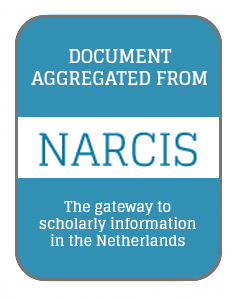Focal point
Location
National Academic Research and Collaborations Information System (NARCIS) is the main Dutch national portal for those looking for information about researchers and their work. NARCIS aggregates data from around 30 institutional repositories. Besides researchers, NARCIS is also used by students, journalists and people working in educational and government institutions as well as the business sector.
NARCIS provides access to scientific information, including (open access) publications from the repositories of all the Dutch universities, KNAW, NWO and a number of research institutes, datasets from some data archives as well as descriptions of research projects, researchers and research institutes.
This means that NARCIS cannot be used as an entry point to access complete overviews of publications of researchers (yet). However, there are more institutions that make all their scientific publications accessible via NARCIS. By doing so, it will become possible to create much more complete publication lists of researchers.
In 2004, the development of NARCIS started as a cooperation project of KNAW Research Information, NWO, VSNU and METIS, as part of the development of services within the DARE programme of SURFfoundation. This project resulted in the NARCIS portal, in which the DAREnet service was incorporated in January 2007. NARCIS has been part of DANS since 2011.
DANS - Data Archiving and Networked Services - is the Netherlands Institute for permanent access to digital research resources. DANS encourages researchers to make their digital research data and related outputs Findable, Accessible, Interoperable and Reusable.
Members:
Resources
Displaying 196 - 200 of 1863INTERLIS Language for Modelling Legal 3D Spaces and Physical 3D Objects by Including Formalized Implementable Constraints and Meaningful Code Lists
The Land Administration Domain Model (LADM) is one of the first ISO spatial domain standards, and has been proven one of the best candidates for unambiguously representing 3D Rights, Restrictions and Responsibilities. Consequently, multiple LADM-based country profile implementations have been developed since the approval of LADM as an ISO standard; however, there is still a gap for technical implementations. This paper summarizes LADM implementation approaches distilled from relevant publications available to date.
To Tree or Not to Tree : Cultural Views from Ancient Romans to Modern Ecologists
Few things are more defining in a landscape compared to the absence or presence of trees, both in aesthetic and in functional terms. At the same time, tree cover has been profoundly affected by humans since ancient times. It is therefore not surprising that opinions about deforestation and colonization of landscapes by trees have always been strong. Although loss of forests is often lamented, there is also profound cultural affection for open landscapes including some that have been deforested in the past.
Volledige openbaarheid: het doel voorbij
Dutch Abstract: De openbare registers voor registergoederen zijn voor iedereen toegankelijk. Eenieder kan inzage verzoeken bij de Dienst voor het kadaster en de openbare registers (‘het Kadaster’). Deze openbare registers dienen het publiciteitsbeginsel in het goederenrecht, dat wordt gezien als een instrument voor het bewerkstelligen van rechtszekerheid met betrekking tot goederenrechtelijke rechten. Daarmee is het beginsel nauw verbonden met de absolute werking van goederenrechtelijke rechten.
The Dutch urban ground lease: A valuable tool for land policy?
Once heralded by both liberals and socialists as a tool for Dutch municipal governments to prevent land speculation and to implement spatial policies, a century later the Dutch ground lease (erfpacht) is now despised by many. The ground lease was the subject of strong debate in the recent past and is likely to remain so. It has been argued that lessees should have the right to become owner of the land, and this ‘right to buy’ has indeed been implemented in the land policies of several municipalities. The Dutch urban ground lease seems to be under serious pressure.
Land Consolidation for Sub-Saharan Africa’s Customary Lands: The Need for Responsible Approaches
This paper explores the potential of land consolidation for dealing with land fragmentation in Sub-Saharan Africa’s (SSA) rural customary lands – where the intention is to increase food productivity. In SSA’s customary lands, the use of mechanized farming technology and intensive farming techniques have largely failed to increase food productivity. This is despite foreign investment and the interest of the farmers to do so. In many cases, neither the farm parcel structure nor the land tenure arrangements support the use of, or investment in, mechanized equipment.


